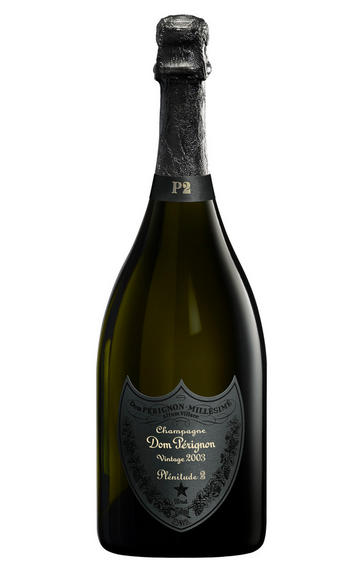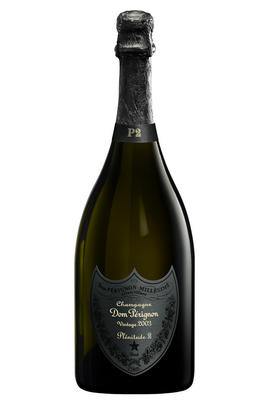
2003 Champagne Dom Pérignon, Plénitude 2, Brut

Critics reviews
The 2003 Dom Pérignon P2 is rich and demonstrative, wafting from the glass with aromas of stone fruits, honeycomb and buttered toast that leave more space for the wine's generous fruit tones than the more overtly yeasty original disgorgement. Full-bodied, broad and textural, it remains very youthful despite its below-average acidity, with notable precision to its ripe fruit tones and chalky structuring extract that provides, to some extent, a compensating sensation of freshness; it's actually evolving more slowly than its 2002 counterpart. Given the wine's richness, it works best with food. Chaperon relates that then-Chef de Caves Richard Geoffroy rejected any musts with a pH exceeding 3.3, the only time this metric has been used as a basis for selection for Dom Pérignon, and that the juice was allowed to oxidize before vinification. I'm looking forward to seeing the 2003 in its P3 incarnation, as I suspect that the wine will really come into its own when it develops more tertiary notes.
Drink 2021 - 2045
William Kelley, Wine Advocate (Sep 2021)
Jancis Robinson MW
James Suckling, jamessuckling.com
The bouquet of 2003 P2 is striking for its diverse range of complex scents. Succulent and exuberant aromas of white fruit such as pear and peach but also of mirabelle plum have an underlying olfactive counterpoint reminiscent of a salty sea breeze, which imparts an oceanic as well as an earthy dimension enhanced by notes of flint, smoke, and verbena. On the palate, there is impressive density and a seemingly tannic sensation that provides structure to the fleshy mouthfeel, while sneaky acidity and bewitching bitterness provide a flourish to the long finish. Time has proven to be a valuable ally indeed for this massive yet harmonious Dom Pérignon, one of its kind.
Drink 2021 - 2040
Yohan Castaing, Decanter.com (May 2021)
About this WINE

Dom Perignon
Dom Pérignon was the 17th century Benedictine monk who has gone down in history as the person who "invented" Champagne. His name was originally registered by Eugène Mercier. He sold the brand name to Moët & Chandon, which used it as the name for its prestige cuvée, which was first released in 1937.
A rigorous selection process in both the vineyard and winery ensures that only the best grapes go into Dom Pérignon champagne. Chardonnay and Pinot Noir are used in roughly equal proportions without one variety dominating the other.
In its youth, Dom Pérignon shows incredibly smooth, creamy fruit with perfect balance and weight. As it ages, it takes on wonderfully toasty aromas and a finesse equalled by very few of the other Grandes Marques.
Since 2014 Dom Pérignon has no longer been using the term oenothèque for its late-release Champagnes, but the word Plenitude. This style represents Dom Pérignon champagne that is left in contact with its lees and does not evolve in a linear fashion, but ages in a series of stages, producing “windows of opportunity, or plenitudes” when the Champagne can be disgorged and released to bring consumers a different expression of the same vintage.
There are three plenitudes in the life of a given vintage: the first plenitude spans between seven to eight years after the vintage, which is when Dom Pérignon Vintage is released, while the second one arrives between 12 and 15 years – which was previously the first oenothèque release, but from now will be branded as P2. The third window comes after around 30 years, when the Champagne has spent more than 20 years on its lees, which will now be termed as P3.

Brut Champagne
Brut denotes a dry style of Champagne (less than 15 grams per litre). Most Champagne is non-vintage, produced from a blend from different years. The non-vintage blend is always based predominately on wines made from the current harvest, enriched with aged wines (their proportion and age varies by brand) from earlier harvests, which impart an additional level of complexity to the end wine. Champagnes from a single vintage are labelled with the year reference and with the description Millésimé.
Non-vintage Champagnes can improve with short-term ageing (typically two to three years), while vintages can develop over much longer periods (five to 30 years). The most exquisite and often top-priced expression of a house’s style is referred to as Prestige Cuvée. Famous examples include Louis Roederer's Cristal, Moët & Chandon's Dom Pérignon, and Pol Roger's Cuvée Sir Winston Churchill.
Recommended Producers : Krug, Billecart Salmon, Pol Roger, Bollinger, Salon, Gosset, Pierre Péters, Ruinart

Champagne blend
Which grapes are included in the blend, and their proportion, is one of the key factors determining the style of most Champagnes. Three grapes are used - Pinot Noir, Chardonnay and Pinot Meunier.
26% of vineyards in Champagne are planted with Chardonnay and it performs best on the Côtes des Blancs and on the chalk slopes south of Epernay. It is relatively simple to grow, although it buds early and thus is susceptible to spring frosts. It produces lighter, fresher wines than those from Burgundy and gives finesse, fruit and elegance to the final blend. It is the sole grape in Blancs de Blancs, which are some of the richest long-lived Champagnes produced.
Pinot Noir accounts for nearly 40% of the plantings in Champagne and lies at the heart of most blends - it gives Champagne its body, structure, strength and grip. It is planted across Champagne and particularly so in the southern Aube district.
The final component is Pinot Meunier and this constitutes nearly 35% of the plantings. Its durability and resistance to spring frosts make the Marne Valley, a notorious frost pocket, its natural home. It ripens well in poor years and produces a soft, fruity style of wine that is ideal for blending with the more assertive flavours of Pinot Noir. Producers allege that Pinot Meunier lacks ageing potential, but this does not deter Krug from including around 15% of it in their final blends.


Buying options
Add to wishlist
Description
This is the result of nearly 15 years of cellar ageing. With this time comes an added power that doesn’t feature in standard vintage Dom Pérignon. The nose has beautiful ripe orchard fruit, honeysuckle and freshly baked pastry. The palate is as rich as one would expect from Plénitude 2 in this hot vintage. But the balance of a creamy acidity and flint-like minerality give the wine a lively balance. There are layers of marzipan and candied pineapple, apricot compote, warm breakfast pastry and liquorice. A wonderful salinity rounds out this remarkable wine. I thoroughly enjoyed this recently, but I dream of how well it will develop over 8-10 years in the cellar.
Drink now to 2040.
Paul Keating, Private Account Manager (June 2021)
wine at a glance
Delivery and quality guarantee